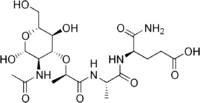Chemistry:Muramyl dipeptide

| |
| Names | |
|---|---|
| IUPAC name
(4R)-4-[ [(2S)-2-[ [(2R)-2-[(2R,5S)-3-acetamido-2,5-dihydroxy-6-(hydroxymethyl)oxan-4-yl]oxypropanoyl]amino]propanoyl]amino]-5-amino-5-oxopentanoic acid
| |
| Other names
Acetylmuramyl-Alanyl-Isoglutamine
| |
| Identifiers | |
3D model (JSmol)
|
|
| ChemSpider | |
| MeSH | Muramyl+dipeptide |
PubChem CID
|
|
| UNII | |
| |
| |
| Properties | |
| C19H32N4O11 | |
| Molar mass | 492.47758 |
Except where otherwise noted, data are given for materials in their standard state (at 25 °C [77 °F], 100 kPa). | |
| Infobox references | |
Muramyl dipeptide is a component of bacterial peptidoglycan, a recognition structure or activator for nucleotide-binding oligomerization domain 2 (NOD2) protein.[1] It is a constituent of both Gram-positive and Gram-negative bacteria composed of N-acetylmuramic acid linked by its lactic acid moiety to the N-terminus of an L-alanine D-isoglutamine dipeptide.[1] It can be recognized by the immune system as a pathogen-associated molecular pattern and activate the NALP3 inflammasome which, in turn, leads to cytokine activation, IL-1α and IL-1β especially.[2]
Human NOD2 protein of the nucleotide-binding leucine-rich repeat family, is a cytoplasmic receptor involved in host innate immune system defense. Mutations in the CARD15 gene encoding NOD2 protein have been observed in Crohn's disease patients,[3] decreasing the immune systems of these patients ability to recognize muramyl dipeptide. Analogues of muramyl dipeptide and their potential for immune response therapies in cancer and disease are being investigated.[4] Experiments published in 2008 showed that muramyl dipeptide is involved in a molecular pathway in mice that conferred protection from colitis.[5]
See also
- Taxol
- Dipeptide
- Mifamurtide, a synthetic analogue for the treatment of osteosarcoma
References
- ↑ 1.0 1.1 "Host recognition of bacterial muramyl dipeptide mediated through NOD2. Implications for Crohn's disease". The Journal of Biological Chemistry 278 (8): 5509–5512. February 2003. doi:10.1074/jbc.C200673200. PMID 12514169.
- ↑ "Identification of bacterial muramyl dipeptide as activator of the NALP3/cryopyrin inflammasome". Current Biology 14 (21): 1929–1934. November 2004. doi:10.1016/j.cub.2004.10.027. PMID 15530394.
- ↑ "Host recognition of bacterial muramyl dipeptide mediated through NOD2. Implications for Crohn's disease". The Journal of Biological Chemistry 278 (8): 5509–5512. February 2003. doi:10.1074/jbc.c200673200. PMID 12514169.
- ↑ "Chemical conjugation of muramyl dipeptide and paclitaxel to explore the combination of immunotherapy and chemotherapy for cancer". Glycoconjugate Journal 25 (5): 415–425. July 2008. doi:10.1007/s10719-007-9095-3. PMID 18161023.
- ↑ "Muramyl dipeptide activation of nucleotide-binding oligomerization domain 2 protects mice from experimental colitis". The Journal of Clinical Investigation 118 (2): 545–559. February 2008. doi:10.1172/JCI33145. PMID 18188453.
 |

